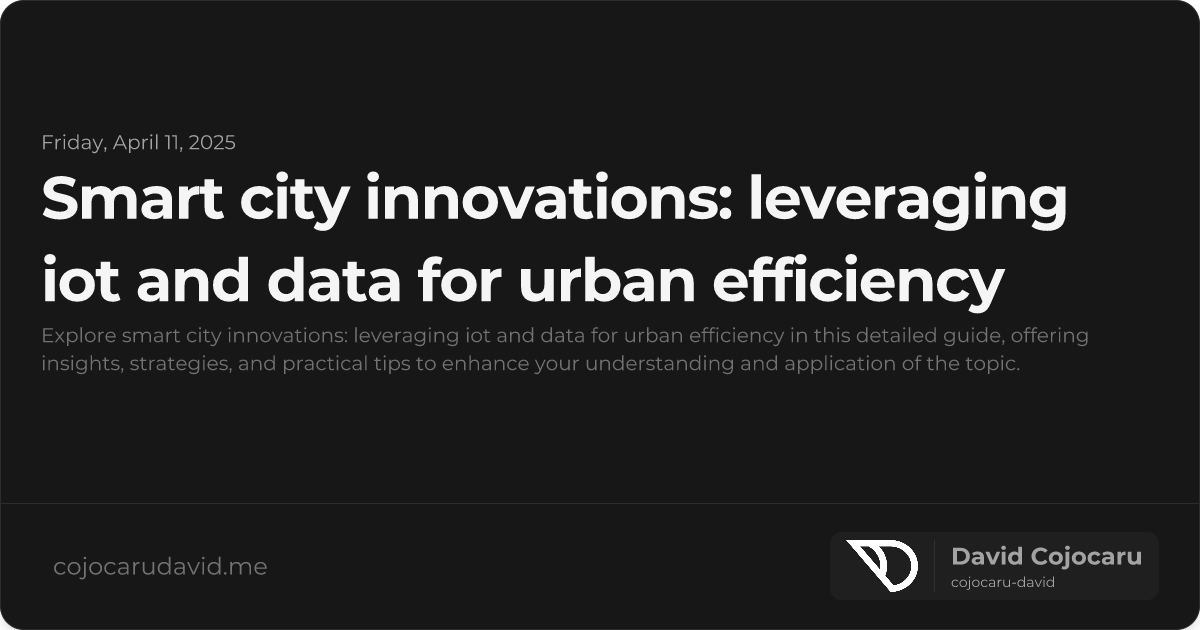Transforming Urban Living: How Smart Cities Leverage IoT and Data
The world’s urban centers are rapidly growing, demanding innovative solutions to improve efficiency, sustainability, and quality of life. This post explores how “smart cities” are transforming urban landscapes by leveraging the power of the Internet of Things (IoT) and data-driven strategies. We’ll delve into how interconnected technologies, AI, and real-time analytics optimize everything from traffic flow to energy consumption, creating more livable and responsive environments.
The Central Role of IoT in Smart City Infrastructure
The Internet of Things (IoT) forms the crucial foundation of smart city infrastructure. A vast network of sensors, cameras, and connected devices constantly collects data, providing cities with real-time insights for informed decision-making and proactive management.
Key IoT Applications Shaping Urban Areas
-
Intelligent Traffic Management: IoT-enabled traffic lights adapt in real-time to traffic congestion, optimizing flow and reducing commute times.
-
Optimized Waste Management: Smart bins utilize sensors to notify collection services only when full, minimizing unnecessary pickups and reducing fuel consumption.
-
Enhanced Energy Efficiency: Smart grids dynamically optimize electricity distribution, lowering energy costs and reducing carbon emissions.
Data: The Fuel Powering Smart Urban Planning
Data analytics transforms raw information into actionable intelligence, empowering city planners to make data-backed decisions. Predictive modeling can accurately forecast infrastructure needs, while AI-powered tools dramatically improve emergency response times and resource allocation.
The Tangible Benefits of Data Integration in Urban Settings
-
Proactive Public Safety: Predictive crime mapping algorithms enable more effective allocation of police resources, improving community safety.
-
Seamless Mobility Solutions: Ride-sharing applications leverage real-time traffic data to suggest the most efficient routes, reducing congestion and travel times.
-
Sustainable Urban Development: Environmental sensors continuously monitor pollution levels, allowing for targeted interventions and improved air quality.
Navigating Challenges and Implementing Effective Solutions
While the potential of smart cities is immense, challenges such as data privacy concerns and infrastructure costs must be addressed.
Strategies for Overcoming Barriers to Smart City Adoption
-
Robust Cybersecurity Measures: Implementing encrypted networks and stringent security protocols to protect sensitive citizen data and maintain public trust.
-
Strategic Public-Private Partnerships: Fostering collaboration between government entities and private companies to share financial burdens and leverage expertise.
-
Scalable and Modular Solutions: Designing IoT systems with a modular approach to allow for gradual implementation and adaptation to evolving needs.
The Exciting Future Landscape of Smart Cities
Emerging technologies like 5G and edge computing will significantly accelerate the development and adoption of smart city technologies. Imagine autonomous vehicles navigating city streets, drones delivering packages efficiently, and AI-powered governance systems optimizing resource allocation in real-time.
Exploring Future Trends and Innovations
-
Digital Twins: Replicating Reality: Creating virtual city models that simulate real-world scenarios, allowing for improved planning, testing, and risk assessment.
-
Blockchain for Enhanced Transparency: Utilizing secure, decentralized ledgers to increase trust in public services and ensure transparent data management.
Conclusion: Embracing the Future of Urban Living
Smart city innovations are fundamentally reshaping how we live, work, and interact with urban environments. By embracing IoT and data-driven strategies, cities can become more sustainable, resilient, and citizen-centric, creating thriving urban spaces for generations to come.
“The smart city isn’t just about technology; it’s about creating a more human-centered urban experience that enhances the lives of its inhabitants.”

